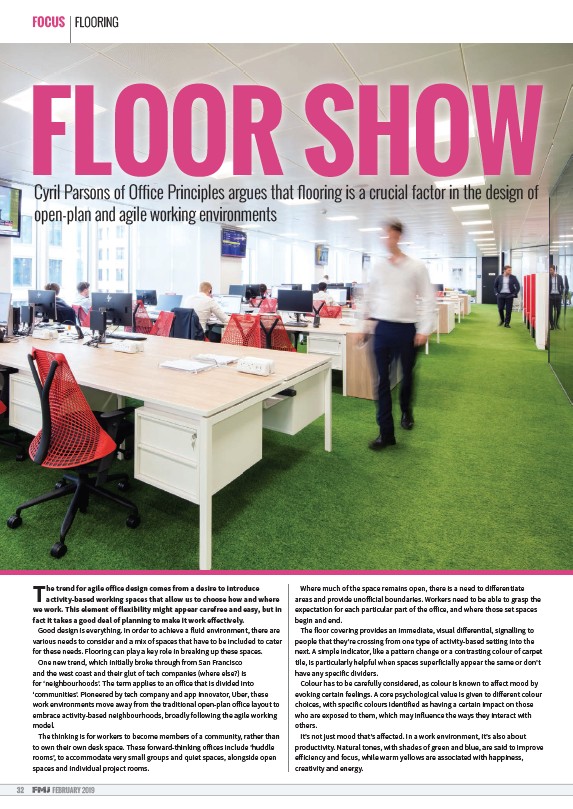
FOCUS FLOORING
FLOOR SHOW Cyril Parsons of 2Ɲ ce Principles argues that fl ooring is a crucial factor in the design of
openplan and agile working environments
The trend for agile o€ ice design comes from a desire to introduce
activity-based working spaces that allow us to choose how and where
we work. This element of flexibility might appear carefree and easy, but in
fact it takes a good deal of planning to make it work e€ ectively.
Good design is everything. In order to achieve a fluid environment, there are
various needs to consider and a mix of spaces that have to be included to cater
for these needs. Flooring can play a key role in breaking up these spaces.
One new trend, which initially broke through from San Francisco
and the west coast and their glut of tech companies (where else?) is
for ‘neighbourhoods’. The term applies to an o ice that is divided into
‘communities’. Pioneered by tech company and app innovator, Uber, these
work environments move away from the traditional open-plan o ice layout to
embrace activity-based neighbourhoods, broadly following the agile working
model.
The thinking is for workers to become members of a community, rather than
to own their own desk space. These forward-thinking o ices include ‘huddle
rooms’, to accommodate very small groups and quiet spaces, alongside open
spaces and individual project rooms.
32 FEBRUARY 2019
Where much of the space remains open, there is a need to di erentiate
areas and provide uno icial boundaries. Workers need to be able to grasp the
expectation for each particular part of the o ice, and where those set spaces
begin and end.
The floor covering provides an immediate, visual di erential, signalling to
people that they’re crossing from one type of activity-based setting into the
next. A simple indicator, like a pattern change or a contrasting colour of carpet
tile, is particularly helpful when spaces superficially appear the same or don’t
have any specific dividers.
Colour has to be carefully considered, as colour is known to a ect mood by
evoking certain feelings. A core psychological value is given to di erent colour
choices, with specific colours identified as having a certain impact on those
who are exposed to them, which may influence the ways they interact with
others.
It’s not just mood that’s a ected. In a work environment, it’s also about
productivity. Natural tones, with shades of green and blue, are said to improve
e iciency and focus, while warm yellows are associated with happiness,
creativity and energy.